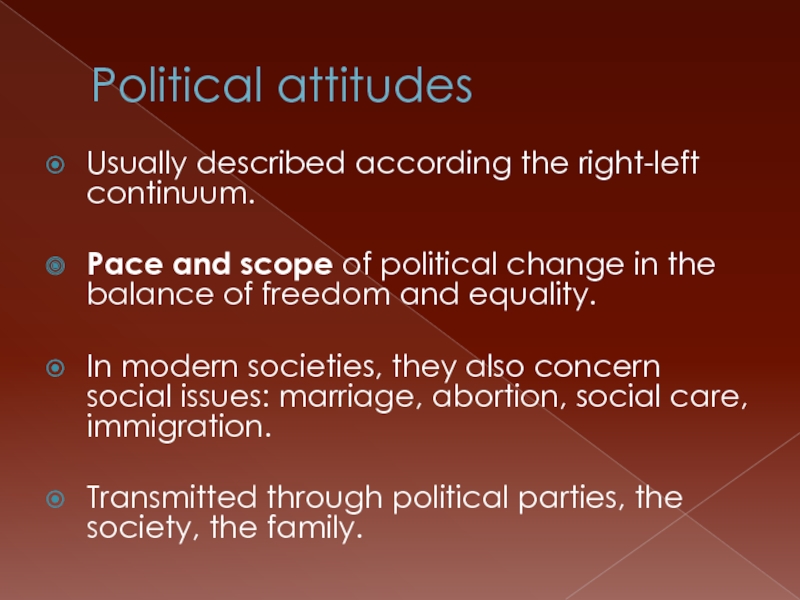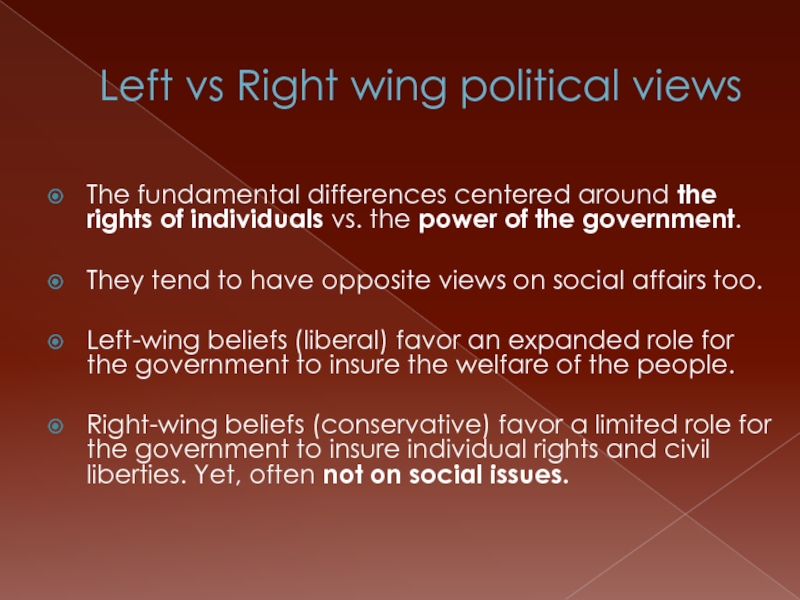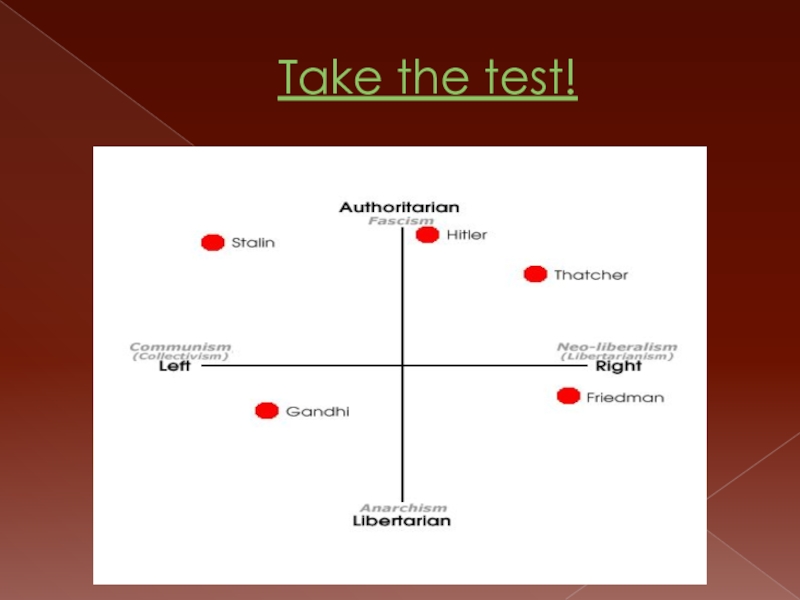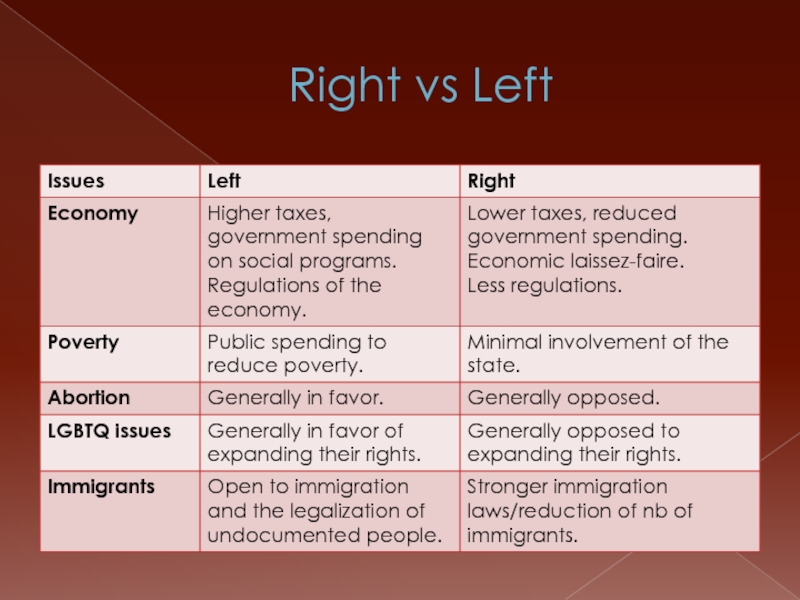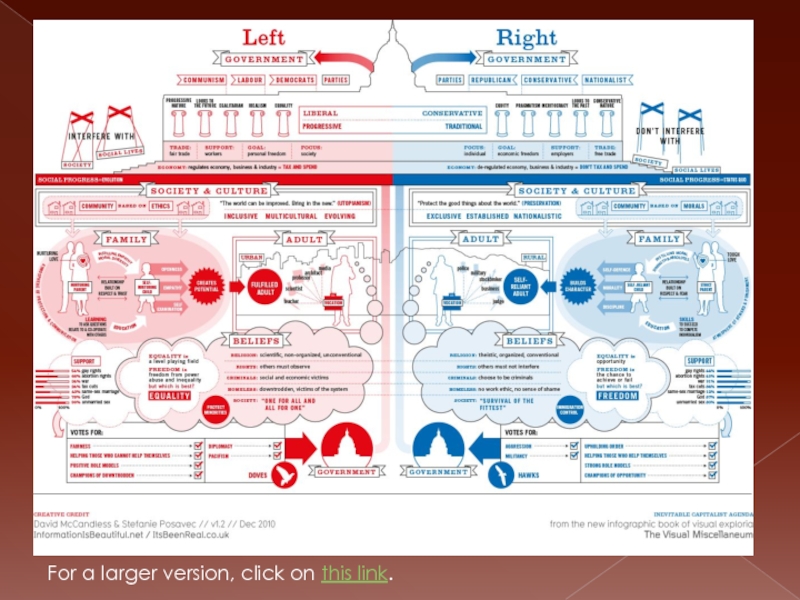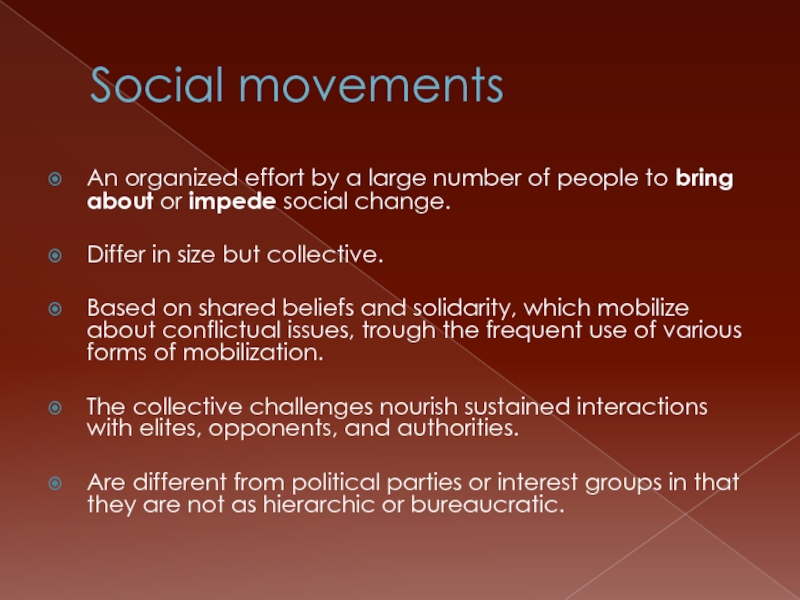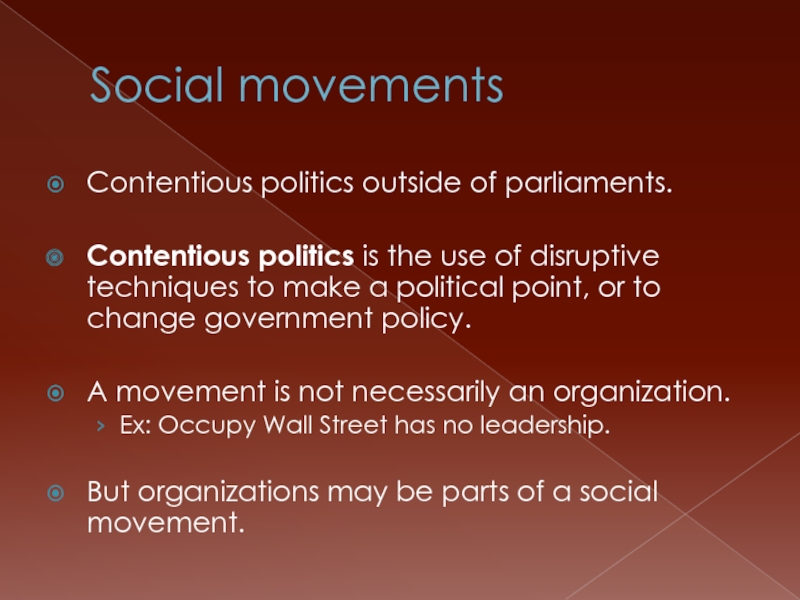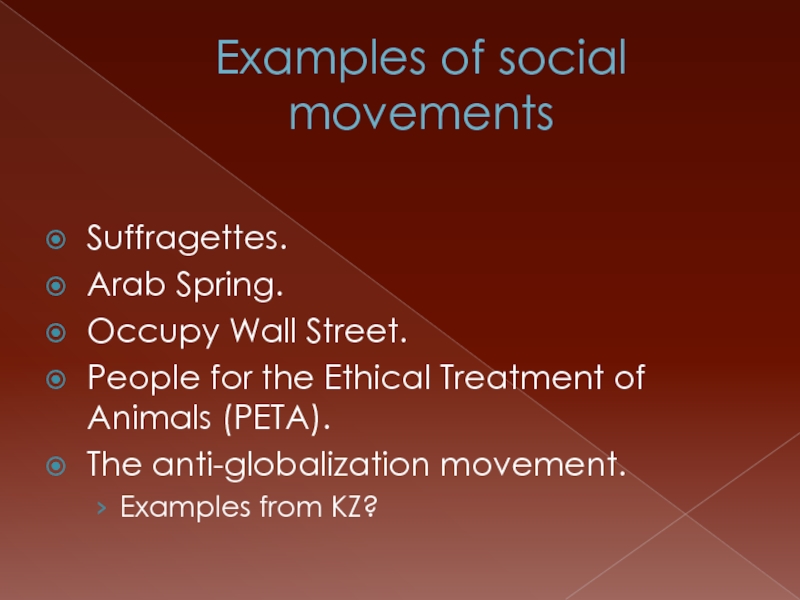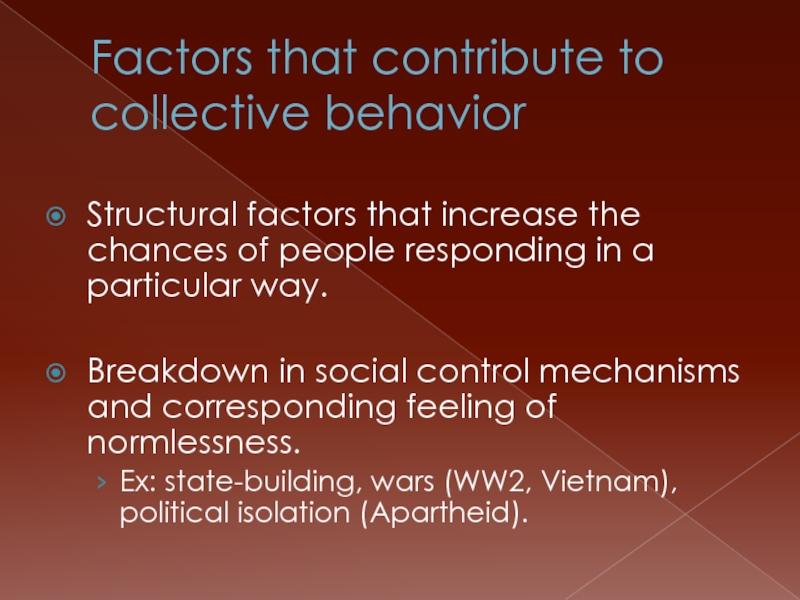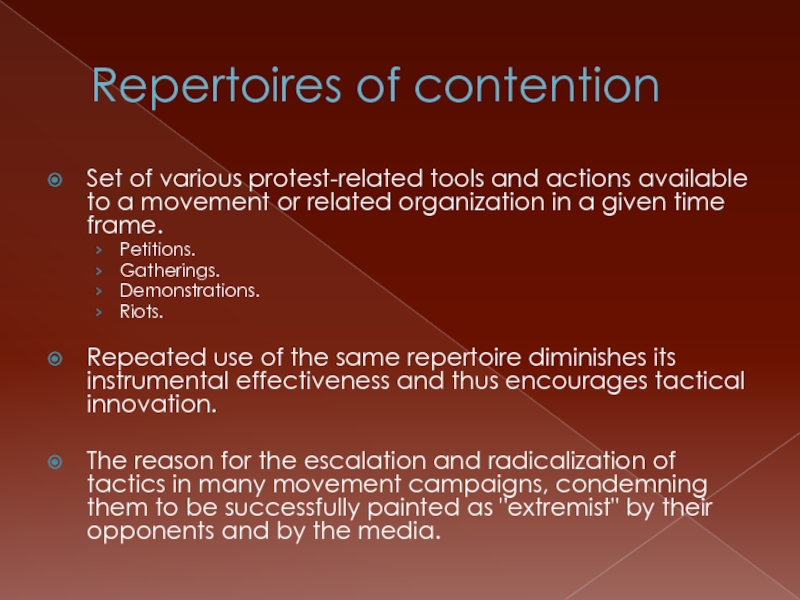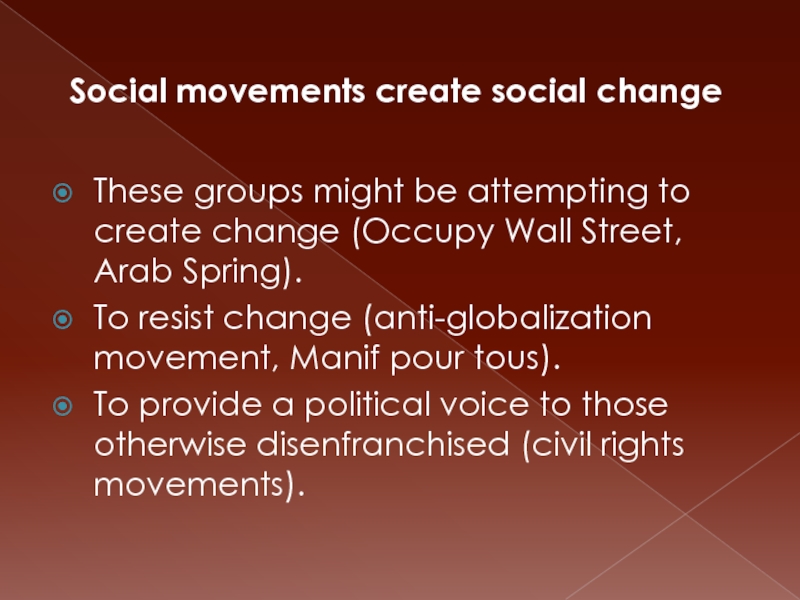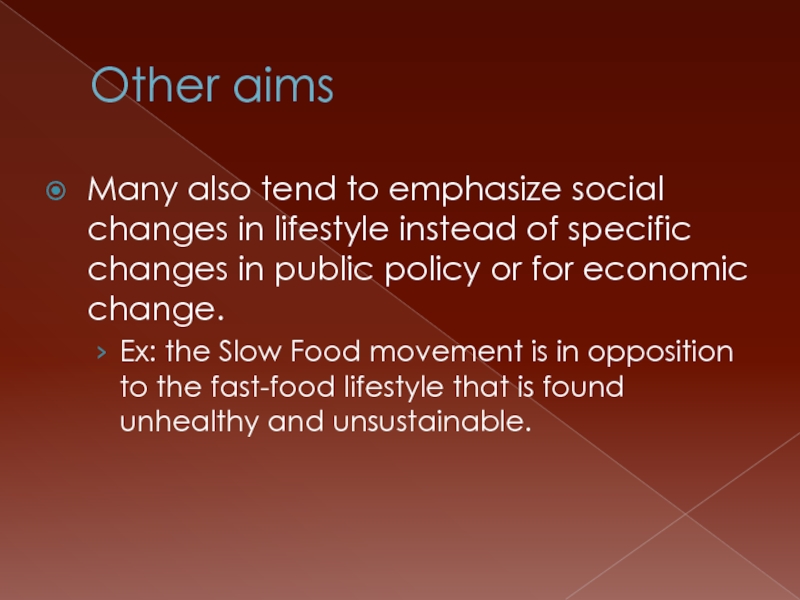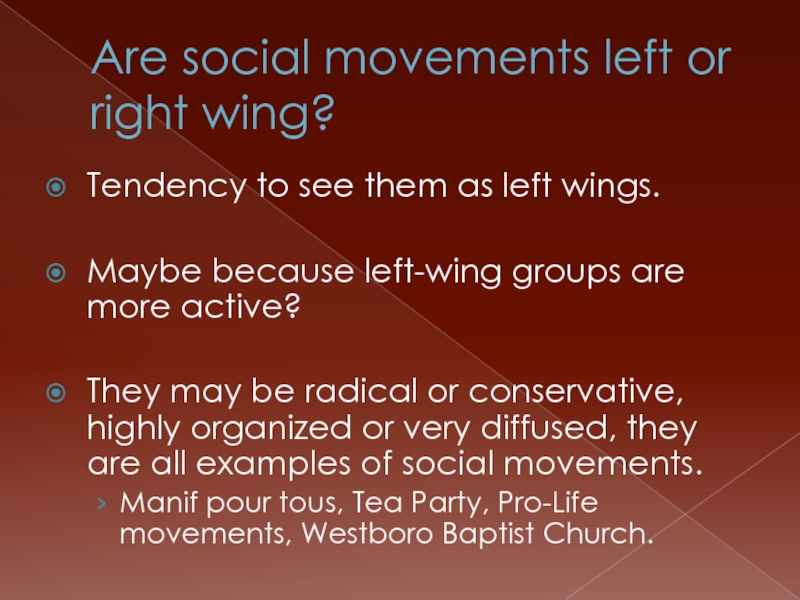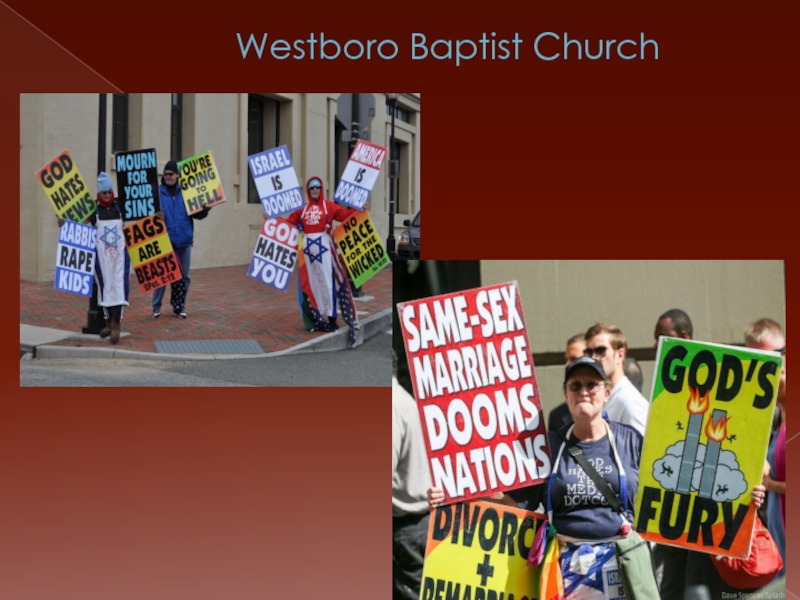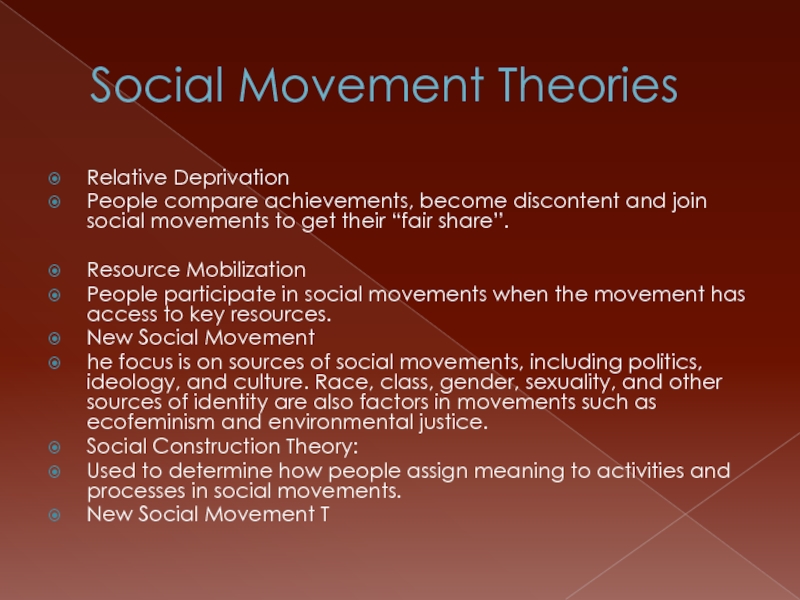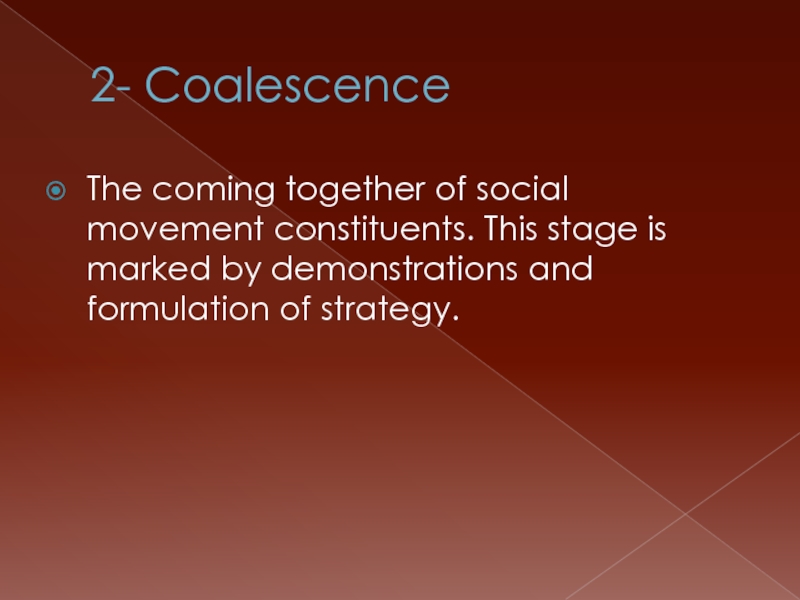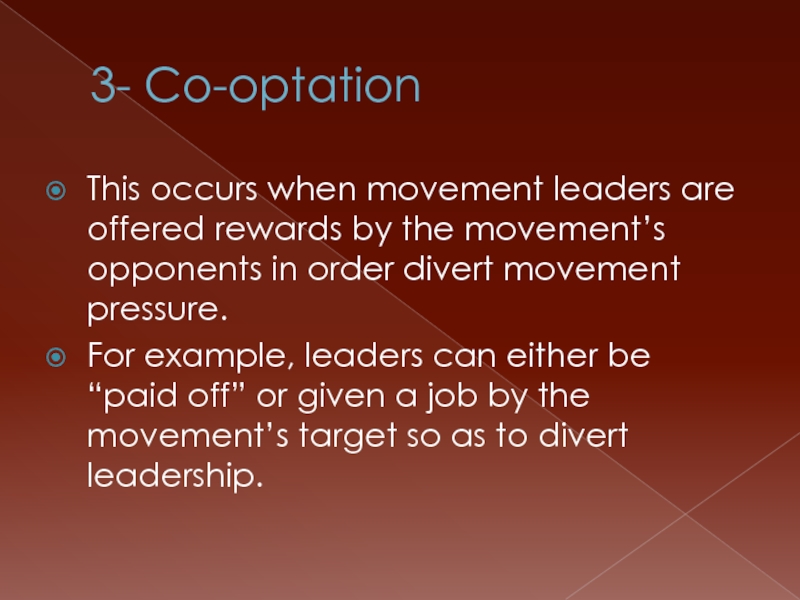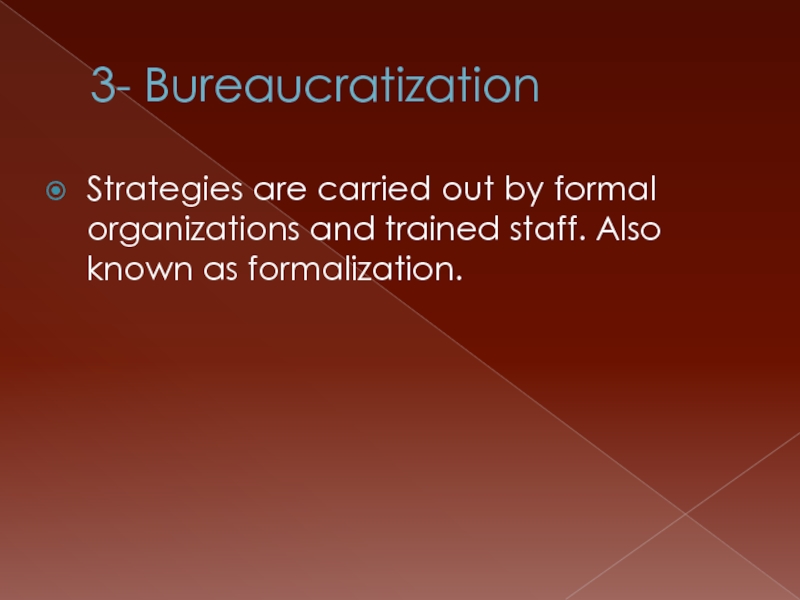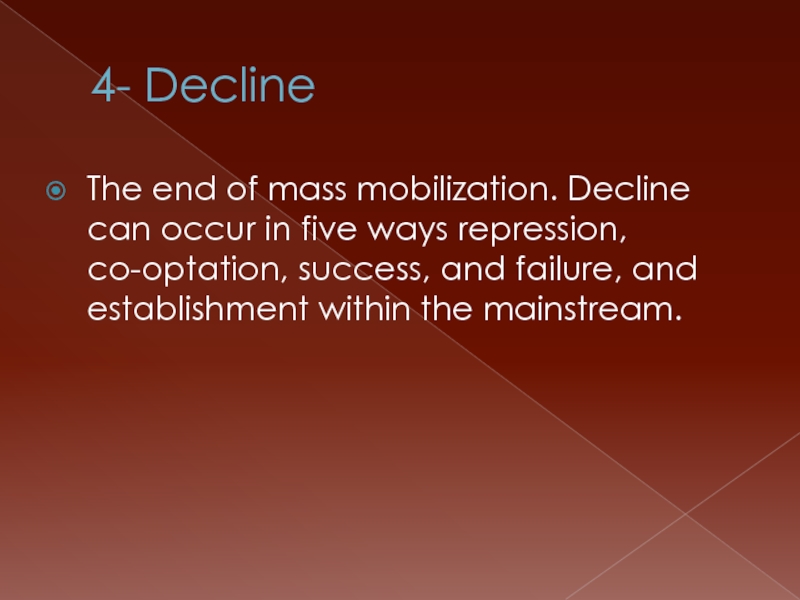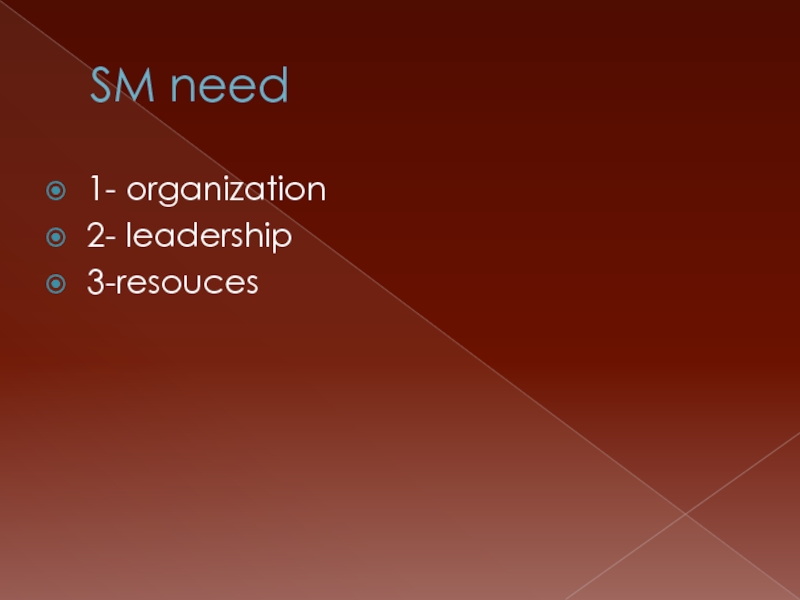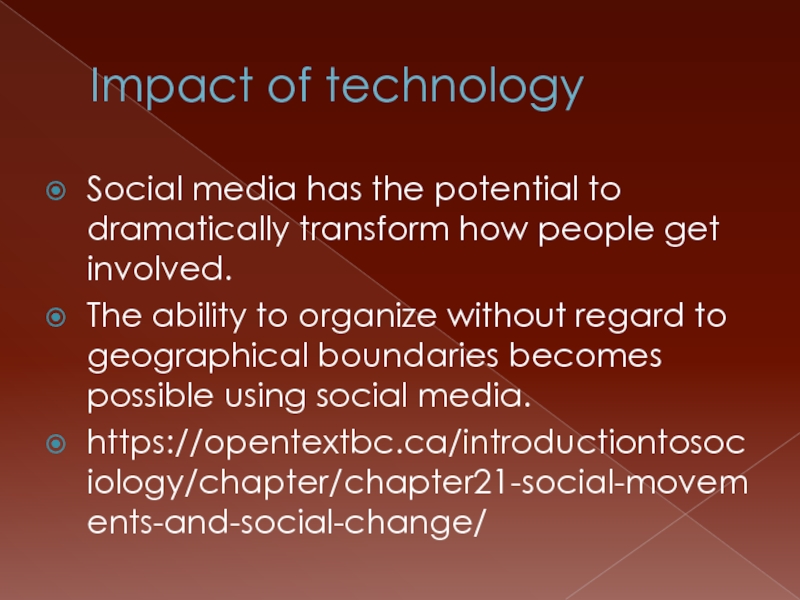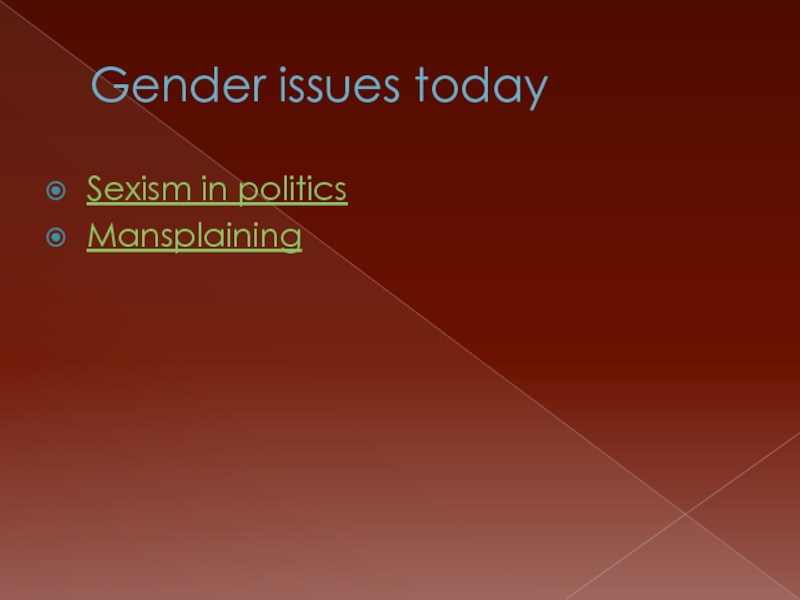September 5
Social movements
- Главная
- Разное
- Дизайн
- Бизнес и предпринимательство
- Аналитика
- Образование
- Развлечения
- Красота и здоровье
- Финансы
- Государство
- Путешествия
- Спорт
- Недвижимость
- Армия
- Графика
- Культурология
- Еда и кулинария
- Лингвистика
- Английский язык
- Астрономия
- Алгебра
- Биология
- География
- Детские презентации
- Информатика
- История
- Литература
- Маркетинг
- Математика
- Медицина
- Менеджмент
- Музыка
- МХК
- Немецкий язык
- ОБЖ
- Обществознание
- Окружающий мир
- Педагогика
- Русский язык
- Технология
- Физика
- Философия
- Химия
- Шаблоны, картинки для презентаций
- Экология
- Экономика
- Юриспруденция
Introduction to comparative politics. Social movements презентация
Содержание
- 1. Introduction to comparative politics. Social movements
- 2. Political attitudes Usually described according the right-left
- 3. Left vs Right wing political views The
- 4. Take the test!
- 5. Right vs Left
- 6. For a larger version, click on this link.
- 7. Political culture Societies’ norms for political activity.
- 8. Social movements An organized effort by a
- 9. Social movements Contentious politics outside of parliaments.
- 10. Examples of social movements Suffragettes. Arab Spring.
- 11. Factors that contribute to collective behavior
- 12. Emergence The better the movements’ symbols, networks
- 13. Repertoires of contention Set of various protest-related
- 14. These groups might be attempting to create
- 15. Other aims Many also tend to emphasize
- 16. Are social movements left or right wing?
- 17. Westboro Baptist Church
- 18. Social Movement Theories Relative Deprivation People
- 19. Four stages of SM 1- Emergence Individualized,
- 20. 2- Coalescence The coming together of social
- 21. 3- Co-optation This occurs when movement leaders
- 22. 3- Bureaucratization Strategies are carried out by
- 23. 4- Decline The end of mass mobilization.
- 24. SM need 1- organization 2- leadership 3-resouces
- 25. Impact of technology Social media has the
- 26. Rather than increasing engagement, he contends
- 27. Gender issues today Sexism in politics Mansplaining
Слайд 2Political attitudes
Usually described according the right-left continuum.
Pace and scope of
political change in the balance of freedom and equality.
In modern societies, they also concern social issues: marriage, abortion, social care, immigration.
Transmitted through political parties, the society, the family.
In modern societies, they also concern social issues: marriage, abortion, social care, immigration.
Transmitted through political parties, the society, the family.
Слайд 3Left vs Right wing political views
The fundamental differences centered around the
rights of individuals vs. the power of the government.
They tend to have opposite views on social affairs too.
Left-wing beliefs (liberal) favor an expanded role for the government to insure the welfare of the people.
Right-wing beliefs (conservative) favor a limited role for the government to insure individual rights and civil liberties. Yet, often not on social issues.
They tend to have opposite views on social affairs too.
Left-wing beliefs (liberal) favor an expanded role for the government to insure the welfare of the people.
Right-wing beliefs (conservative) favor a limited role for the government to insure individual rights and civil liberties. Yet, often not on social issues.
Слайд 7Political culture
Societies’ norms for political activity.
Modernization theory predicts that cultures change
with economic development → secular societies.
Counter-examples?
Does globalization lead to the liberalization of cultures around the world?
Changes greatly over time.
Ex: Egypt, conservatism in the US, LGBTQ rights etc.
Counter-examples?
Does globalization lead to the liberalization of cultures around the world?
Changes greatly over time.
Ex: Egypt, conservatism in the US, LGBTQ rights etc.
Слайд 8Social movements
An organized effort by a large number of people to
bring about or impede social change.
Differ in size but collective.
Based on shared beliefs and solidarity, which mobilize about conflictual issues, trough the frequent use of various forms of mobilization.
The collective challenges nourish sustained interactions with elites, opponents, and authorities.
Are different from political parties or interest groups in that they are not as hierarchic or bureaucratic.
Differ in size but collective.
Based on shared beliefs and solidarity, which mobilize about conflictual issues, trough the frequent use of various forms of mobilization.
The collective challenges nourish sustained interactions with elites, opponents, and authorities.
Are different from political parties or interest groups in that they are not as hierarchic or bureaucratic.
Слайд 9Social movements
Contentious politics outside of parliaments.
Contentious politics is the use of
disruptive techniques to make a political point, or to change government policy.
A movement is not necessarily an organization.
Ex: Occupy Wall Street has no leadership.
But organizations may be parts of a social movement.
A movement is not necessarily an organization.
Ex: Occupy Wall Street has no leadership.
But organizations may be parts of a social movement.
Слайд 10Examples of social movements
Suffragettes.
Arab Spring.
Occupy Wall Street.
People for the Ethical Treatment
of Animals (PETA).
The anti-globalization movement.
Examples from KZ?
The anti-globalization movement.
Examples from KZ?
Слайд 11Factors that contribute to collective behavior
Structural factors that increase the
chances of people responding in a particular way.
Breakdown in social control mechanisms and corresponding feeling of normlessness.
Ex: state-building, wars (WW2, Vietnam), political isolation (Apartheid).
Breakdown in social control mechanisms and corresponding feeling of normlessness.
Ex: state-building, wars (WW2, Vietnam), political isolation (Apartheid).
Слайд 12Emergence
The better the movements’ symbols, networks resources, the easier it will
be to exploit even modest opportunities.
When successful, movements create opportunities for other movements, which can also borrow repertoires of contention from unrelated movements.
When successful, movements create opportunities for other movements, which can also borrow repertoires of contention from unrelated movements.
Слайд 13Repertoires of contention
Set of various protest-related tools and actions available to
a movement or related organization in a given time frame.
Petitions.
Gatherings.
Demonstrations.
Riots.
Repeated use of the same repertoire diminishes its instrumental effectiveness and thus encourages tactical innovation.
The reason for the escalation and radicalization of tactics in many movement campaigns, condemning them to be successfully painted as "extremist" by their opponents and by the media.
Petitions.
Gatherings.
Demonstrations.
Riots.
Repeated use of the same repertoire diminishes its instrumental effectiveness and thus encourages tactical innovation.
The reason for the escalation and radicalization of tactics in many movement campaigns, condemning them to be successfully painted as "extremist" by their opponents and by the media.
Слайд 14These groups might be attempting to create change (Occupy Wall Street,
Arab Spring).
To resist change (anti-globalization movement, Manif pour tous).
To provide a political voice to those otherwise disenfranchised (civil rights movements).
To resist change (anti-globalization movement, Manif pour tous).
To provide a political voice to those otherwise disenfranchised (civil rights movements).
Social movements create social change
Слайд 15Other aims
Many also tend to emphasize social changes in lifestyle instead
of specific changes in public policy or for economic change.
Ex: the Slow Food movement is in opposition to the fast-food lifestyle that is found unhealthy and unsustainable.
Ex: the Slow Food movement is in opposition to the fast-food lifestyle that is found unhealthy and unsustainable.
Слайд 16Are social movements left or right wing?
Tendency to see them as
left wings.
Maybe because left-wing groups are more active?
They may be radical or conservative, highly organized or very diffused, they are all examples of social movements.
Manif pour tous, Tea Party, Pro-Life movements, Westboro Baptist Church.
Maybe because left-wing groups are more active?
They may be radical or conservative, highly organized or very diffused, they are all examples of social movements.
Manif pour tous, Tea Party, Pro-Life movements, Westboro Baptist Church.
Слайд 18Social Movement Theories
Relative Deprivation
People compare achievements, become discontent and join
social movements to get their “fair share”.
Resource Mobilization
People participate in social movements when the movement has access to key resources.
New Social Movement
he focus is on sources of social movements, including politics, ideology, and culture. Race, class, gender, sexuality, and other sources of identity are also factors in movements such as ecofeminism and environmental justice.
Social Construction Theory:
Used to determine how people assign meaning to activities and processes in social movements.
New Social Movement T
Resource Mobilization
People participate in social movements when the movement has access to key resources.
New Social Movement
he focus is on sources of social movements, including politics, ideology, and culture. Race, class, gender, sexuality, and other sources of identity are also factors in movements such as ecofeminism and environmental justice.
Social Construction Theory:
Used to determine how people assign meaning to activities and processes in social movements.
New Social Movement T
Слайд 19Four stages of SM
1- Emergence
Individualized, but widespread feelings of discontent and
windows of opportunity.
Movements in this stage lack clearly defined strategy for achieving goals and little organization.
Movements in this stage lack clearly defined strategy for achieving goals and little organization.
Слайд 202- Coalescence
The coming together of social movement constituents. This stage is
marked by demonstrations and formulation of strategy.
Слайд 213- Co-optation
This occurs when movement leaders are offered rewards by the
movement’s opponents in order divert movement pressure.
For example, leaders can either be “paid off” or given a job by the movement’s target so as to divert leadership.
For example, leaders can either be “paid off” or given a job by the movement’s target so as to divert leadership.
Слайд 223- Bureaucratization
Strategies are carried out by formal organizations and trained staff.
Also known as formalization.
Слайд 234- Decline
The end of mass mobilization. Decline can occur in five
ways repression, co-optation, success, and failure, and establishment within the mainstream.
Слайд 25Impact of technology
Social media has the potential to dramatically transform how
people get involved.
The ability to organize without regard to geographical boundaries becomes possible using social media.
https://opentextbc.ca/introductiontosociology/chapter/chapter21-social-movements-and-social-change/
The ability to organize without regard to geographical boundaries becomes possible using social media.
https://opentextbc.ca/introductiontosociology/chapter/chapter21-social-movements-and-social-change/
Слайд 26
Rather than increasing engagement, he contends that social media only increases
participation; after all, the cost of participation is so much lower than the cost of engagement.

